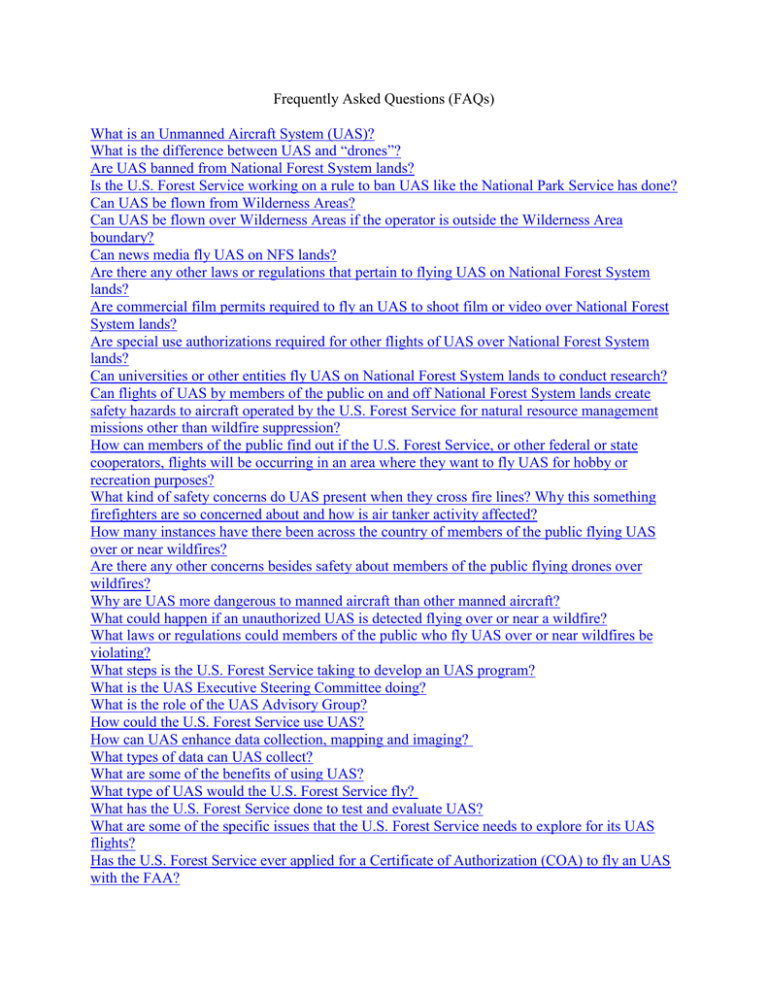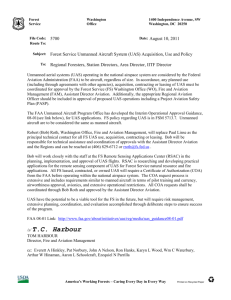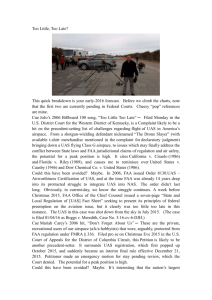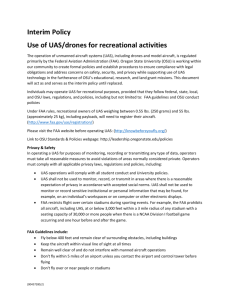Frequently Asked Questions (FAQs) What is an Unmanned Aircraft System (UAS)?
advertisement

Frequently Asked Questions (FAQs) What is an Unmanned Aircraft System (UAS)? What is the difference between UAS and “drones”? Are UAS banned from National Forest System lands? Is the U.S. Forest Service working on a rule to ban UAS like the National Park Service has done? Can UAS be flown from Wilderness Areas? Can UAS be flown over Wilderness Areas if the operator is outside the Wilderness Area boundary? Can news media fly UAS on NFS lands? Are there any other laws or regulations that pertain to flying UAS on National Forest System lands? Are commercial film permits required to fly an UAS to shoot film or video over National Forest System lands? Are special use authorizations required for other flights of UAS over National Forest System lands? Can universities or other entities fly UAS on National Forest System lands to conduct research? Can flights of UAS by members of the public on and off National Forest System lands create safety hazards to aircraft operated by the U.S. Forest Service for natural resource management missions other than wildfire suppression? How can members of the public find out if the U.S. Forest Service, or other federal or state cooperators, flights will be occurring in an area where they want to fly UAS for hobby or recreation purposes? What kind of safety concerns do UAS present when they cross fire lines? Why this something firefighters are so concerned about and how is air tanker activity affected? How many instances have there been across the country of members of the public flying UAS over or near wildfires? Are there any other concerns besides safety about members of the public flying drones over wildfires? Why are UAS more dangerous to manned aircraft than other manned aircraft? What could happen if an unauthorized UAS is detected flying over or near a wildfire? What laws or regulations could members of the public who fly UAS over or near wildfires be violating? What steps is the U.S. Forest Service taking to develop an UAS program? What is the UAS Executive Steering Committee doing? What is the role of the UAS Advisory Group? How could the U.S. Forest Service use UAS? How can UAS enhance data collection, mapping and imaging? What types of data can UAS collect? What are some of the benefits of using UAS? What type of UAS would the U.S. Forest Service fly? What has the U.S. Forest Service done to test and evaluate UAS? What are some of the specific issues that the U.S. Forest Service needs to explore for its UAS flights? Has the U.S. Forest Service ever applied for a Certificate of Authorization (COA) to fly an UAS with the FAA? What is an Unmanned Aircraft System (UAS)? Collectively, an UAS consists of an aircraft platform, sensor and communication payloads, and the ground control segment. Federal Aviation Administration (FAA) policy identifies “Unmanned Aircraft (UA) as ‘aircraft’ flown by a ‘pilot’ regardless of where the pilot is located. The U.S. Forest Service has adopted the same policy. What is the difference between UAS and “drones”? The term “drone” no longer adequately describes the capabilities of UAS, which is the term used by the FAA. However, “drone” is commonly used to refer to UAS. Are UAS banned from National Forest System lands? No. However, there are areas on National Forest System lands where UAS can’t be flown by law and shouldn’t be flown in accordance with FAA guidelines. The areas where UAS can’t be operated from by law include Wilderness Areas and areas with Temporary Flight Restrictions (TFRs) in place, such as wildfires. The areas where they shouldn’t be flown in accordance with FAA safety guidelines include: Campgrounds and trailheads (FAA safety guidelines include “Don’t fly near people…” U.S. Forest Service helibases, airtanker bases, and other aircraft facilities including backcountry airstrips (FAA safety guidelines include “Don’t fly within 5 miles of an airport unless you contact the airport and control tower before flying.” Areas where aircraft are performing wildfire suppression or other natural resource management missions, such as aerial surveys for forest health protection (FAA safety guidelines include “Remain well clear of and do not interfere with manned aircraft operations”). The FAA has regulatory authority over all airspace, including flights of UAS by the public, businesses, and government agencies. Members of the public who fly UAS for hobby or recreational purposes only must follow the FAA’s Model Aircraft Operations and FAA Advisory Circular. The FAA safety guidelines for model aircraft operations include “Don’t fly near people…” Flying UAS over campgrounds, trailheads, and other locations where people are typically found on National Forest System lands would violate this safety guideline. Additional information about responsible use for members of the public that want to fly UAS on National Forest System Land can be found at website. Persons or entities seeking to fly a UAS on National Forest System lands for commercial purposes generally must meet the FAA’s requirements for Civil Operations (NonGovernmental). Businesses must also request a special use authorization from the U.S. Forest Service which will be evaluated in accordance with agency and FAA requirements to determine if use will be approved. Government agencies must meet the FAA’s requirements for Public Operations (Governmental). 2 Other government agencies must also request a special use authorization for use of a UAS that is launched, landed, or operated from National Forest System land. Is the U.S. Forest Service working on a rule to ban UAS like the National Park Service has done? Not at the present time. Can UAS be flown from Wilderness Areas? No. UAS are considered to be both “motorized equipment” and “mechanical transport” and as such they cannot take off from, land in, or be operated from congressionally designated Wilderness Areas. Can UAS be flown over Wilderness Areas if the operator is outside the Wilderness Area boundary? Per Federal Aviation Administration (FAA) guidance on “Flights Over Charted U.S. Wildlife Refuges, Parks, and Forest Service Areas,” all aircraft are requested to maintain a minimum altitude of 2,000 feet above the surface of lands and waters of U.S. Forest Service Wilderness Areas. Can news media fly UAS on NFS lands? News media use of UAS is addressed on the FAA website as follows: “News media use of a UAS is not for hobby or recreational purposes, so FAA authorization is necessary. Media organizations may hire a company that already has a Section 333 exemption; that company would have to apply for and obtain a Certificate of Waiver or Authorization (COA) to fly in a particular block of airspace. Media organizations also may apply for their own Section 333 exemptions. See Section 33. News media organizations seeking additional information may contact Alison Duquette, FAA, or Les Dorr, FAA. News media must inquire as to whether a special use authorization is required for use of a UAS on National Forest System land; and/or other reporting activities on the ground (e.g. logistical support vehicles, or other equipment besides a handheld camera) that may need authorization for purposes of public safety or resource protection. For additional information, contact Forest or Regional Office special uses staff. Are there any other laws or regulations that pertain to flying UAS on National Forest System lands? Several Code of Federal Regulations (CFR) sections apply to flights of UAS by members of the public on National Forest System Lands. These include but are not limited to 36 CFR sections 261.1(3) an act or omission that threatens, or endangers a person; 261.4 (d) causing public inconvenience, or alarm by making unreasonably loud noise; 261.18 (a)prohibition against possessing motorized equipment; 261.8 (a) prohibition against molesting wildlife; 261.21(b) prohibition against possessing or using a motor or motorized equipment in primitive areas; 261.10 (d)(1) prohibition against using a implement capable of causing injury or damaging property in or within 150 yards near a campsite; 261.10 (f) placing a vehicle or object in such a manner that it is an impediment or hazard to the safety or convenience of any person; and 261.10 (i) any device that produces noise such as…a motor or engine in such a manner and at such time 3 so as to unreasonably disturb any person, these may or should apply depending on the circumstances. Are commercial film permits required to fly an UAS to shoot film or video over National Forest System lands? The U.S. Forest Service has the authority under 36 CFR 251.54 to require a film permit that involves a commercial flight of an UAS when it is being launched, operated, and landed on National Forest System land. The agency can deny the commercial use of a UAS associated with a request for a commercial film permit if the agency determines through its screening criteria that it is not an appropriate use. For additional information, contact Forest or Regional Office special uses staff. Are special use authorizations required for other flights of UAS over National Forest System lands? Yes. A special use permit may be required if a UAS is launched, operated, and landed on National Forest System land for purposes other than recreation or hobby use. For additional information, contact Forest or Regional Office special uses staff. Can universities or other entities fly UAS on National Forest System lands to conduct research? Universities or other entities may be able to fly UAS on National Forest System lands to conduct research if they have proper FAA authorization and meet U.S. Forest Service requirements. For additional information, contact Forest or Regional Office aviation and special uses staff. Can flights of UAS by members of the public on and off National Forest System lands create safety hazards to aircraft operated by the U.S. Forest Service for natural resource management missions other than wildfire suppression? Yes. The U.S. Forest Service flies aircraft for thousands of hours each year to perform a variety of natural resource management missions. These include forest insect and disease surveys, aerial image and data acquisition, aerial spraying to control or eradicate major forest pests, law enforcement, wildlife telemetry, straw/seeding, and research/crew transport to remote areas for field studies. These flights occur over millions of acres of National Forest System and other lands in multiple states. Some flights (i.e. aerial spraying) occur less than 150 feet above ground level, which creates a high potential for a collision with an UAS operated by a member of the public. How can members of the public find out if the U.S. Forest Service, or other federal or state cooperators, flights will be occurring in an area where they want to fly UAS for hobby or recreation purposes? Members of the public can contact the appropriate U.S. Forest Service unit having administrative jurisdiction (e.g. Ranger District, Field Office, Northeastern Area or Regional Office) where they want to fly a UAS for hobby or recreation purposes or the local FAA office. They can also check FAA websites such as NOTAM, PilotWeb and Temporary Flight Restrictions. 4 What kind of safety concerns do UAS present when they cross fire lines? Why is this something firefighters are so concerned about and how is air tanker activity affected? Firefighter and public safety are the top priorities in wildfire management. Unauthorized UAS flights near a wildfire could cause serious injury or death to firefighters and pilots who are in the air, as well as firefighters and public citizens who are on the ground. Aerial firefighting aircraft, such as airtankers and helicopters, fly at very low altitudes, the same as UAS flown by the general public, creating the potential for mid-air collision that could be fatal for aviation and/or ground firefighters, as well as members of the public. Firefighting aircraft typical fly in smoky, windy, and turbulent conditions. Safety depends on knowing what other aircraft are operating in the airspace and where they are at all times; their safety is compromised by the presence of UAS. How many instances have there been across the country of members of the public flying UAS over or near wildfires? Since 2014, there have been more than 25 documented incidents of members of the public flying UAS over or near wildfires. These are only the incidents that wildland fire management agencies are aware of, there are likely more. Are there any other concerns besides safety about members of the public flying drones over wildfires? Yes, there is the potential for land and homeowners and others to view unauthorized video or photos shot by members of the public flying drones and use that information to make decisions, such as whether or not to evacuate and when to evacuate, instead of official information from the proper authorities such as local law enforcement. Why are UAS more dangerous to manned aircraft than other manned aircraft? Manned aircraft take many measures to ensure the safety of themselves and others. Pilots talk on a common frequency to let others know where they are and where they are heading. Aircraft have transponders that send out a signal with their position and altitude. Pilots and crew are constantly scanning the sky for other aircraft. UAS have none of these safety features. These small aircraft are extremely hard to see and a collision with even a small UAS could be catastrophic for a manned aircraft. What could happen if an unauthorized UAS is detected flying over or near a wildfire? Unauthorized UAS flights could lead fire managers to suspend aerial wildfire suppression operations until the UAS has left the airspace and they are confident it won’t return. Suspending air operations could decrease the effectiveness of wildfire suppression operations; the effects of the lost aircraft airtime could be compounded by potential flames moving into untreated terrain. This delay could allow wildfires to grow larger with the potential to threaten lives and property. Suspended air operations could also delay transportation of firefighters to different locations and add to costs of fighting the fire. What laws or regulations could members of the public who fly UAS over or near wildfires be violating? Members of the public who fly UAS over or near wildfires may be violating FAA and/or U.S. Forest Service regulations, whether a Temporary Flight Restriction (TFR) is in place or not. 5 According to a news release issued by the FAA, which has regulatory authority over all airspace, on July 29, 2015, “Often a temporary flight restriction (TFR) is put in place around wildfires to protect firefighting aircraft. No one other than the agencies involved in the firefighting effort can fly any manned or unmanned aircraft in such a TFR. Anyone who violates a TFR and endangers the safety of manned aircraft could be subject to civil and/or criminal penalties. Even if there is no TFR, operating a UAS could still pose a hazard to firefighting aircraft and would violate Federal Aviation Regulations. If you endanger manned aircraft or people on the ground with an unmanned aircraft, you could be liable for a fine ranging from $1,000 to a maximum of $25,000.” Members of the public who disrupt wildfire suppression operations on National Forest System lands may also be violating the 36 CFR 261.3 (Interfering with a Forest officer, volunteer, or human resource program enrollee or giving false report to a Forest officer. The following are prohibited: (a) Threatening, resisting, intimidating, or interfering with any forest officer engaged in or on account of the performance of his official duties in the protection, improvement, or administration of the National Forest System is prohibited.”). The U.S. Forest Service can use the referenced CFR to take action. Decisions about whether or not to pursue that will ultimately be made by local U.S. Attorneys. In addition, state and local laws/ordinances/regulations may also have some regulation regarding impeding firefighting efforts which might be applied to take action through the appropriate jurisdiction. What steps is the U.S. Forest Service taking to develop an UAS program? The U.S. Forest Service is working towards UAS integration in several ways. The Chief of the U.S. Forest Service has appointed an acting UAS program manager; established an UAS Executive Steering Committee; and chartered an UAS working group. The agency is also continuing to conduct testing and evaluation projects to ensure safety and cost efficiency in multiple mission profiles and developing lessons learned for the smoothest possible integration. What is the UAS Executive Steering Committee doing? The UAS program manager is currently working with the UAS Executive Steering Committee to evaluate U.S. Forest Service policy to identify where updates are needed for UAS. Areas such as data management, privacy, enforcement, training, certifications, and radio spectrum are being assessed. Interagency alignment where possible is also a consideration. What is the role of the UAS Advisory Group? The UAS Advisory Group was chartered to address guidance and use of UAS within the U.S. Forest Service and explore the use of UAS and associated technologies for their potential to support operational needs throughout the agency. This group, which is comprised of technical experts, has been tasked with several items, including conducting a thorough review of agency policy; making policy recommendations; completing a risk assessment; and developing a strategic plan for use of UAS by the agency. After the group has completed these tasks, U.S. Forest Service leadership will determine the future of an UAS program for the agency. 6 How could the U.S. Forest Service use UAS? The U.S. Forest Service could potentially fly UAS to accomplish a wide variety of agency missions: Forest Management – UAS could be flown to map and monitor vegetation and the general condition of forest stands; to sample and estimate biomass and other forest product quantities; to determine the effectiveness of vegetation treatments, reforestation efforts, and achievement of forest management objectives; to monitor timber harvest unit boundaries; to identify road locations; to conduct bridge, dam, and road conditions; to evaluate stream conditions; to monitor impacts on wetlands, rivers and streams, and lakeshores; and to assess damage from extreme weather events, such as wildfires, landslides, hurricanes, floods, ice storms, and high winds. Watershed, Soil, and Air Management – UAS could be flown to map and monitor the general condition and quality of watersheds, soils, and air; to sample air quality at various altitudes; to photograph lichens in remote sites; to determine the effectiveness of watershed restoration projects; and to establish and monitor watershed boundaries. Forest Health Protection – UAS could be flown to detect, assess, and map damage caused by insects and diseases; to inventory regeneration after insect infestation; and to detect populations of invasive plant species and monitor eradication efforts. Fish, Wildlife, and Plants – UAS could be flown to map fish and wildlife habitat; to survey fish and wildlife populations; to monitor populations of threatened and endangered fish, wildlife, and plant species; and to monitor the effectiveness of habitat restoration efforts. Research – UAS could be flown to gather a wide variety of data and images for studies, such as forest canopy condition; movements of migratory birds and bats; plant community distribution; smoke plume measurements; and ash and soil conditions. Recreation – UAS could be flown to monitor trail, landscape, dispersed recreation site and facilities conditions; to monitor visitor use and impacts; and in search and rescue efforts. Law Enforcement – UAS could be flown to detect illegal activities, such as narcotics production, timber theft, and archaeological site vandalism. Fire and Aviation Management – UAS could be flown to detect fires; to assess fire potential; to prioritize fires; to monitor prescribed fires and wildfires being managed to achieve resource objectives; to monitor fire behavior, rate and direction of spread, and flame length; to identify roads and other potential fire breaks, water sources, and potential fireline and helispot locations; to measure temperature, wind direction and speed, and relative humidity; to locate spot fires and values at risk ahead of fires; to facilitate radio and data communications between dispatch, the fireline, and the incident 7 command post; to acquire infrared/Electro Optical [daytime color camera] images; to monitor air quality; and to evaluate the effectiveness of fire management actions. Burned Area Emergency Response/Post-Fire – UAS could be flown to conduct post-fire assessments; to map soil burn severity; to conduct debris flow evaluations; to monitor post-fire vegetation recovery to assess how long flooding threats continue for downstream communities; and to understand fire effects. Special Uses Management – UAS could be flown to verify project placement, activity use, special use compliance with terms and conditions. How can UAS enhance data collection, mapping and imaging? The U.S. Forest Service is currently developing an UAS strategic plan that will outline how UAS and associated technologies can potentially enhance the agency’s capacity to accomplish its various resource management missions. What types of data can UAS collect? UAS can collect real time video; ortho-corrected imagery; stereo imagery; image mosaics; KML/KMZ files; and derived products (maps – invasive plant locations, fire progression; DEM, flight path, fire radiative heat release, fire rate of spread). What are some of the benefits of using UAS? The U.S. Forest Service is in the process of determining cost and safety benefits that could be realized with small (16 foot or less wingspan) UAS platforms when compared with traditional manned aircraft (fixed wing and helicopter) for similar missions. UAS have the potential to enhance the cost effectiveness, safety, quality, and timeliness of many data gathering and image acquisition missions on National Forest System lands by reducing the time and risks associated with accessing remote areas with limited roads and trails and hazards, such as snags; by providing the capability to cover large landscapes and acquire large amounts of data and images at appropriate intervals and scale; by providing the capability to gather data and images for long periods of time; and by providing the capability to acquire data and images in difficult aviation conditions such as smoke, night, low light, and dust. What type of UAS would the U.S. Forest Service fly? The U.S. Forest Service is currently developing a strategic plan that includes agency mission requirements. Those identified requirements will determine the type and capabilities of potential UAS that may be applied in the agency. Potential aircraft will then be reviewed in the context of life cycle costs and Risk Assessments to determine their feasibility for use in the U.S. Forest Service. What has the U.S. Forest Service done to test and evaluate UAS? The UAS Advisory Group is implementing testing and evaluation (T&E) projects to integrate UAS into Agency missions. The goals include validating policy and procedures, determining true operational costs, documenting risks and mitigation plans, addressing policy, determining niche areas, and other issues. In June, 2015, the U.S. Forest Service conducted an inspection of the Placer River Bridge in Alaska flying an UAS. Another project which will pilot contracting for 8 commercial UAS services is moving from the planning to the implementation stages. That project is in the Forest Health Protection aerial survey mission. The U.S. Forest Service is also participating in “Unmanned Aircraft Technology Demonstrations” with the DOI. In 2015, small UAS were flown on two wildfires (Paradise in Washington and Tepee Springs in Idaho) and there was a demonstration of an optionally piloted helicopter at Lucky Peak helibase in Idaho through this project. In previous years, the U.S. Forest Service has investigated the utility of UAS technology to support wildland fire reconnaissance and other resource mapping applications. The bulk of this evaluation has been done through our collaboration with NASA Ames Research Center, the U.S. Geological Survey UAS Program Office, and through small contracts with the vendor community. What are some of the specific issues that the U.S. Forest Service needs to explore for its UAS flights? The issues that the U.S. Forest Service needs to explore include: Mission requirements (with potentially thousands of missions and thousands of aircraft on the market, requirements need to be clear. For example, an Infrared (IR) camera to find a person at 100 degrees is a different spectrum than finding wildfire which is 600 degrees. The standard IR camera that many systems use can do both but not nearly as well as a mission specific sensor. The same is true for aircraft performance. Depending on the altitude the sensor needs to be at for the resolution required and the area that needs coverage, the performance needs of an aircraft can change dramatically) The types and numbers of UAS needed UAS Acquisition (contracting for service, purchasing aircraft, using cooperator aircraft)as quickly as technology changes and with the potential for Mission requirements to vary, in the near term purchase of aircraft might not be a beneficial as contracting. Estimated cost of aircraft ownership and life cycle (WCF, Contracted, cooperator) Agency aircraft and pilot standards (qualifications and staffing levels) Data management (storage, distribution, and architecture requirements) Inspection standards for aircraft and pilots Documentation of risks and mitigation plans Policy Has the U.S. Forest Service ever applied for a Certificate of Authorization (COA) to fly an UAS with the FAA? Yes, the U.S. Forest Service has previously applied for and received several COAs from the FAA. The purpose of the COAs was to evaluate small UAS capabilities. The U.S. Forest Service provided input for a COA from the FAA while assisting the National Aeronautics and Space Administration (NASA) when operating the Ikhana over several active fires in the western United States. 9




